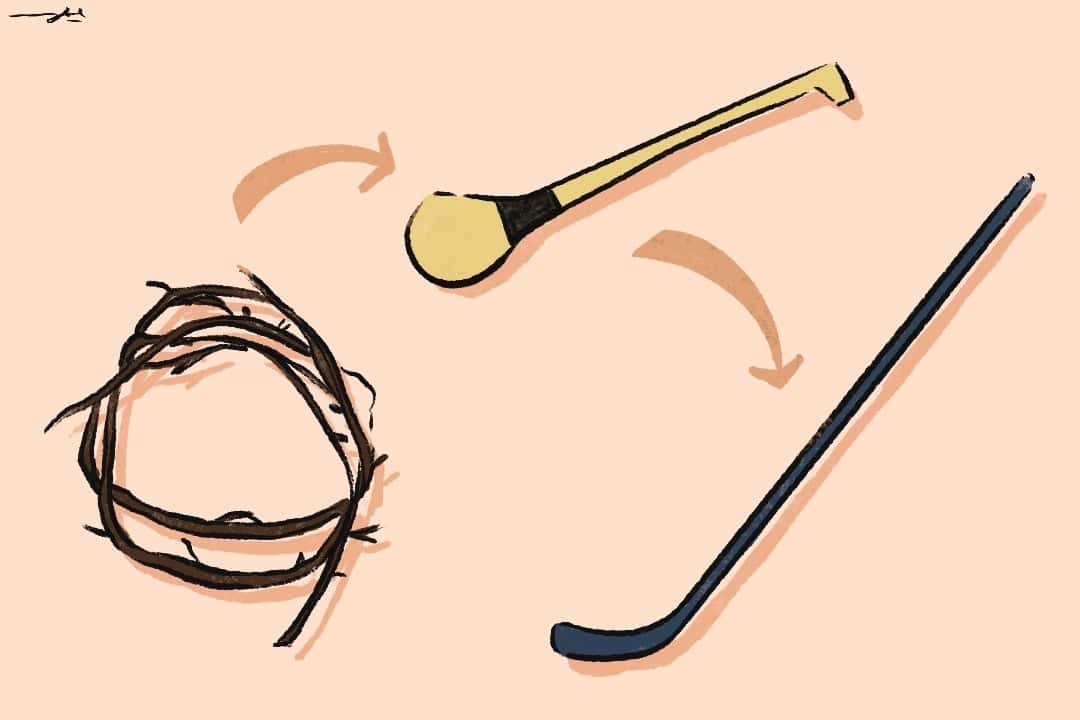Before 1875 — the year the International Ice Hockey Federation declared to have had the first-ever organized game of ice hockey in Montréal — Mi’kmaw communities in Nova Scotia had already been playing a similar game. Even before carbon dating revealed that a precursor of the hockey stick, likely made by a Mi’kmaw carver from darkened yellow birch, dated back to the seventeenth century, the oral history of the Mi’kmaq told us as much. With this, one can see not only the origins of the game, but also its evolution.
Before the making of hockey sticks became industrialized in the 1930s, the Mi’kmaq of Nova Scotia carved their own sticks and sold them internationally. Mi’kmaq carvers often used hornbeam trees, native to Nova Scotia and known for their durability — and their odour. Similarly, carvers sometimes used yellow birch, another durable hardwood.
Oochamkunutk and hurley on ice
Alchamadijik is a Mi’kmaw term used to describe early versions of the modern game of ice hockey. The game’s origins can be traced back to similar games called Oochamkunutk in the Mi’kmaq language, a term that refers to field and ice games. Alchamadijik seems to have emerged through a combination of Oochamkunutk and a game called ‘hurley on ice,’ — a European rendition of an Irish field game — and the sport we know today began taking shape.
At first, players played hurley on ice with a hard wooden ball, but this was eventually changed to barrel plugs, or ‘cork-bungs,’ possibly due to frequent shin injuries. Cork-bungs look similar to the pucks used today and hockey historians have suggested that the game’s modern name comes from hock ale — a beer brewed and stored in barrels with bungs — made for Hocktide, a medieval English festival.
Contemporary hurley sticks are carved from the wood of the ash tree and shaped so that the ball can be balanced on the blade as players run with it. However, before this alteration in 1920, hurley sticks resembled present-day ice hockey sticks.
Duwarken
Along with Alchamadijik, hurley on ice, and Oochamkunutk, there was another traditional Mi’kmaw game which featured a ball played on ice — Duwarken. In the game, a striker would hit a round stone on the ice with a stick. In 1913, Jerry Lonecloud, who was Mi’kmaw from Nova Scotia, described this stick as likely to be a spruce root known to players as Duwarkenaught. The stone was then retrieved by a player, with opposition players attempting to take it from the stone carrier before they could return it to the striker.
It may be that the hockey stick we know today is inspired by a combination of the spruce roots used in Duwarken and the sticks used in hurling, made possible through the skills of Mi’kmaw wood carvers.
Ricket
European accounts from the late 1600s record that Mi’kmaw players also played an early version of ice hockey, known as ‘ricket.’ These news articles and observations detail that the game featured two ‘rickets,’ each consisting of two stones that were placed about three feet apart that would act as a goalpost.
The game’s goal was to score with a cherrywood puck through the opposing ricket, which a player guarded. Once teammates were chosen by their captains, they would take their sticks and throw the ball into the air, commencing the game. The similarities between ricket and ice hockey are clear.
Ice hockey’s roots can be traced back to different games played by the Mi’kmaq in Nova Scotia. European stick and ball games such as hurley have also likely influenced the game we play today. Ice hockey emerged by embracing cultural contact between both European and Mi’kmaw games.



No comments to display.